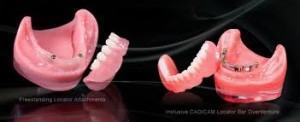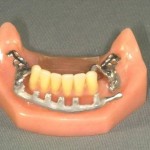The first requirement of a major connector is rigidity. This allows stresses that are applied to the partial denture to be distributed effectively over the entire supporting area, including the teeth, underlying, bone and soft tissue. Other components of a partial prosthesis can only be effective if the major connector is rigid. Flexibility allows forces to be concentrated on individual teeth or edentulous ridges causing damage to those areas. Continue reading
Tag Archives: partial denture
Chrome cobalt dentures – Q & A
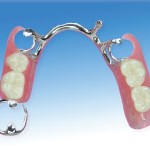 What is chrome cobalt denture?
What is chrome cobalt denture?
Chrome cobalt dentures are dentures made from cast cobalt chrome framework/base. They are made of a type of allow which consists of cobalt, chrome, chromium (which is added to prevent corrosion). Continue reading
What is an Overdenture for Teeth?
Advanced periodontal or gum disease usually cause loose or painful teeth. If many of your teeth have become loose or painful, it may be too late for to save them. In such a situation, removing some of your teeth and replacing them with an overdenture may be the best way to avoid infection and restore function and health to your mouth. Continue reading
Preprosthetic surgery
How to Kiss With a Partial Denture
Wearing dentures can take a bit of practice, especially when it comes to inserting them and taking them out. Most people will adapt to dentures relatively easily, however, with just a bit of practice. You’ll also find that most normal activities, like speaking and eating, even whistling, can be done with dentures as well. Kissing with dentures is essentially the same as kissing without them. If you’re feeling nervous about the idea, there are a few things you can do to help relieve your anxiety and ensure a pleasant experience for all concerned. Continue reading
Swing Lock Partial Dentures
The swing-lock removable partial denture (SL), was introduced by Simmons in the early 1960s. Swing lock partial dentures are designed for dental patients who have depleted dentition. They are sometimes used because traditional partial dentures can be unreliable due to rather limited bracing and clasping abilities. These limitations result in a weak resistance to rotational forces. To overcome this problem, the swing lock partial denture design makes it possible to clasp multiple teeth at a time, therefore increasing the bracing and reduce the rotational movements of the denture. Continue reading
Types of Ultrathin Dentures
Dentures have a bad rap of being unsightly, uncomfortable, and difficult to eat with. However, advances in the way that dentures are made have resulted in dentures that are easy to wear, look great, and—most importantly—fit snugly and comfortably. Ultrathin dentures may be made out of a variety of materials and can fit any number of budgets. Continue reading
Questions and Answers :Flexible Dentures
What are flexible dentures?
Normal acrylic dentures are hard, rigid and can fracture when they are dropped accidentally. Flexible dentures are introduced by Valplast Company (during 1950s) and as their name suggest, they are flexible in nature. Continue reading
What Materials Are Dentures Made From?
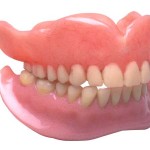 Any denture wearers would like their dentures to be stable, retentive and esthetic. Thus  ,choosing a good material to construct denture will ensure a well fitting and natural looking denture. Continue reading
Any denture wearers would like their dentures to be stable, retentive and esthetic. Thus  ,choosing a good material to construct denture will ensure a well fitting and natural looking denture. Continue reading
Problems With Partial Dentures
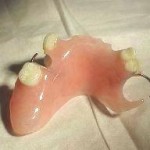 There are some common problems that can occur from wearing removable partial denture.
There are some common problems that can occur from wearing removable partial denture.
PLAQUE ACCUMULATION
Plaque accumulation is the most seen effect as plaque is accumulated more at the denture bearing areas and around teeth where components are placed. This can be avoided by meticulous maintenance of oral hygiene and proper cleaning of denture. Continue reading
